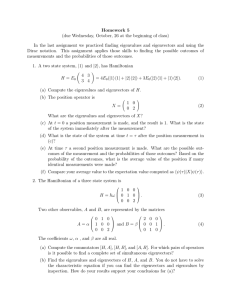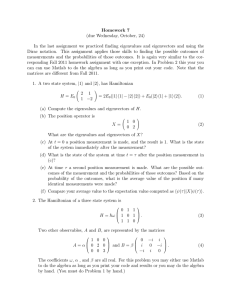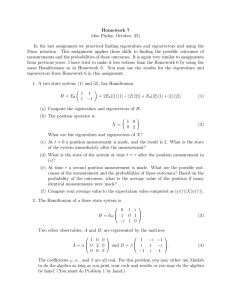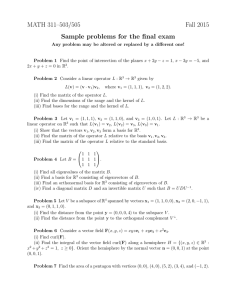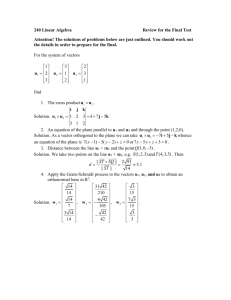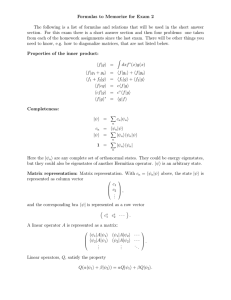MATH 423 Linear Algebra II Lecture 33: Diagonalization of normal operators.
advertisement
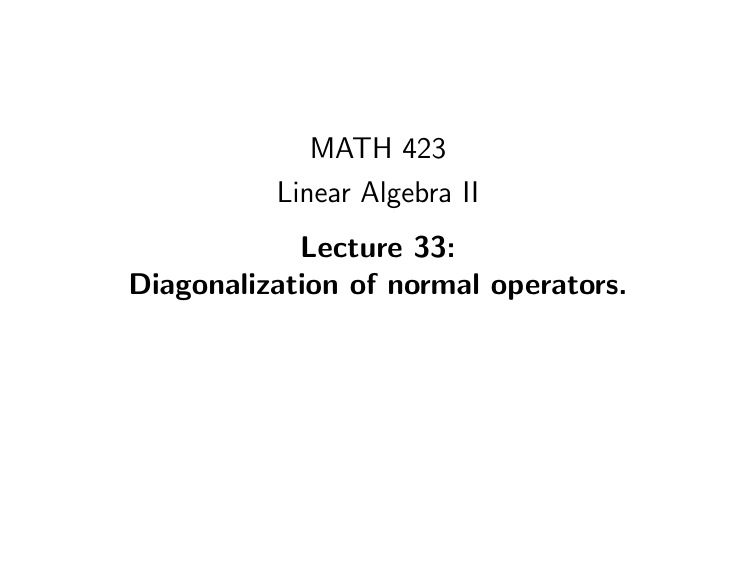
MATH 423
Linear Algebra II
Lecture 33:
Diagonalization of normal operators.
Adjoint operator and adjoint matrix
Given a linear operator L on an inner product space
V , the adjoint of L is a transformation L∗ : V → V
satisfying hL(x), yi = hx, L∗ (y)i for all x, y ∈ V .
Theorem 1 If V is finite-dimensional, then the
adjoint operator L∗ always exists.
Given a matrix A with complex entries, its adjoint
matrix is A∗ = At .
Theorem 2 If A is the matrix of a linear operator
L relative to an orthonormal basis β, then the
matrix of L∗ relative to the same basis is A∗ .
Let L : V → V be a linear operator on an inner product space
V . Recall that N (L) denotes the null-space of L and R(L)
denotes the range of L:
N (L) = {x ∈ V | L(x) = 0}, R(L) = {L(y) | y ∈ V }.
Theorem If the adjoint operator L∗ exists, then
N (L) = R(L∗ )⊥ as well as N (L∗ ) = R(L)⊥ .
Proof: x ∈ N (L) ⇐⇒ L(x) = 0 ⇐⇒ hL(x), yi = 0 for all
y ∈ V ⇐⇒ hx, L∗ (y)i = 0 for all y ∈ V ⇐⇒ x ⊥ R(L∗ )
⇐⇒ x ∈ R(L∗ )⊥ .
The second equality follows in the same way since (L∗ )∗ = L.
Example. V = Rn with the dot product, L(x) = Ax, where
A ∈ Mn,n (R) and vectors are regarded as column vectors.
We have L∗ (x) = A∗ x for all x ∈ Rn . The range of L∗ is the
column space of the matrix A∗ = At , which is the row space
of A. Therefore N (L) = {null-space of the matrix A} is the
orthogonal complement of the row space of A.
Normal operators
Definition. A linear operator L on an inner product
space V is called normal if it commutes with its
adjoint. That is, if the adjoint operator L∗ exists
and L◦L∗ = L∗ ◦L.
There are several special classes of normal operators
important for applications.
The operator L is self-adjoint if L∗ = L.
Equivalently, hL(x), yi = hx, L(y)i for all x, y ∈ V .
The operator L is anti-selfadjoint if L∗ = −L.
The operator L is unitary if L∗ = L−1 .
Normal matrices
Definition. A square matrix A with real or complex entries is
normal if AA∗ = A∗ A.
Theorem Let L be a linear operator on a finite-dimensional
inner product space. Suppose A is the matrix of L relative to
an orthonormal basis. Then the operator L is normal if and
only if the matrix A is normal.
Special classes of normal operators give rise to special classes
of normal matrices.
A matrix A ∈ Mn,n (C) is Hermitian if A∗ = A,
skew-Hermitian if A∗ = −A, and unitary if A∗ = A−1 .
A square matrix B with real entries is symmetric if B t = B,
skew-symmetric if B t = −B, and orthogonal if B t = B −1 .
Properties of normal operators
Theorem Suppose L is a normal operator on an
inner product space V . Then
(i) kL(x)k = kL∗ (x)k for all x ∈ V ;
(ii) N (L) = N (L∗ );
(iii) an operator given by x 7→ L(x) − λx is normal
for any scalar λ;
(iv) the operators L and L∗ share eigenvectors;
namely, if L(v) = λv then L∗ (v) = λv;
(v) eigenvectors of L belonging to distinct
eigenvalues are orthogonal;
(vi) if a subspace V0 ⊂ V is invariant under L,
then the orthogonal complement V0⊥ is also
invariant under L.
Properties of normal operators
• kL(x)k = kL∗ (x)k for all x ∈ V .
kL(x)k2 = hL(x), L(x)i = hx, L∗ (L(x))i = hx, L(L∗ (x))i
= hL(L∗ (x)), xi = hL∗ (x), L∗ (x)i = hL∗ (x), L∗ (x)i = kL(x)k2 .
• If v1 and v2 are eigenvectors of L belonging to
distinct eigenvalues λ1 and λ2 , then hv1 , v2 i = 0.
We have L(v1 ) = λ1 v1 and L∗ (v2 ) = λ2 v2 . Then
λ1 hv1 , v2 i = hλ1 v1 , v2 i = hL(v1 ), v2 i = hv1 , L∗ (v2 )i
= hv1 , λ2 v2 i = λ2 hv1 , v2 i.
It follows that (λ1 − λ2 )hv1 , v2 i = 0. Since λ1 6= λ2 , we
obtain hv1 , v2 i = 0.
Diagonalization of normal operators
Theorem A linear operator L on a finite-dimensional inner
product space V is normal if and only if there exists an
orthonormal basis for V consisting of eigenvectors of L.
Proof (“if”): Suppose β is an orthonormal basis consisting of
eigenvectors of L. Then the matrix A = [L]β is diagonal,
A = diag(λ1 , λ2 , . . . , λn ). Since β is orthonormal,
[L∗ ]β = A∗ = diag(λ1 , λ2 , . . . , λn ). Clearly, AA∗ = A∗ A.
Hence L◦L∗ = L∗ ◦L.
Idea of the proof (“only if”): The statement is derived from
the following two lemmas.
Lemma 1 (Schur’s Theorem) There exists an orthonormal
basis β for V such that the matrix [L]β is upper triangular.
Lemma 2 If a normal matrix is upper triangular, then it is
actually diagonal.
Diagonalization of normal operators
Theorem A linear operator L on a finite-dimensional inner
product space V is normal if and only if there exists an
orthonormal basis for V consisting of eigenvectors of L.
Corollary 1 Suppose L is a normal operator. Then
(i) L is self-adjoint if and only if all eigenvalues of L are real
(λ = λ);
(ii) L is anti-selfadjoint if and only if all eigenvalues of L are
purely imaginary (λ = −λ);
(iii) L is unitary if and only if all eigenvalues of L are of
absolute value 1 (λ = λ−1 ).
Corollary 2 A linear operator L on a finite-dimensional, real
inner product space V is self-adjoint if and only if there exists
an orthonormal basis for V consisting of eigenvectors of L.
Diagonalization of normal matrices
Theorem (a) A ∈ Mn,n (C) is normal ⇐⇒ there exists an
orthonormal basis for Cn consisting of eigenvectors of A;
(b) A ∈ Mn,n (R) is symmetric ⇐⇒ there exists an
orthonormal basis for Rn consisting of eigenvectors of A.
1 0 1
Example. A = 0 3 0 .
1 0 1
• A is symmetric.
• A has three eigenvalues: 0, 2, and 3.
• Associated eigenvectors are v1 = (−1, 0, 1), v2 = (1, 0, 1),
and v3 = (0, 1, 0), respectively.
• Vectors √12 v1 , √12 v2 , v3 form an orthonormal basis for R3 .
Example. Aφ =
cos φ − sin φ
.
sin φ cos φ
• Aφ Aψ = Aφ+ψ
t
• A−1
φ = A−φ = Aφ
• Aφ is orthogonal
• det(Aφ − λI ) = (cos φ − λ)2 + sin2 φ.
• Eigenvalues: λ1 = cos φ + i sin φ = e iφ ,
λ2 = cos φ − i sin φ = e −iφ .
• Associated eigenvectors: v1 = (1, −i),
v2 = (1, i).
• Vectors √12 v1 and √12 v2 form an orthonormal
basis for C2 .

